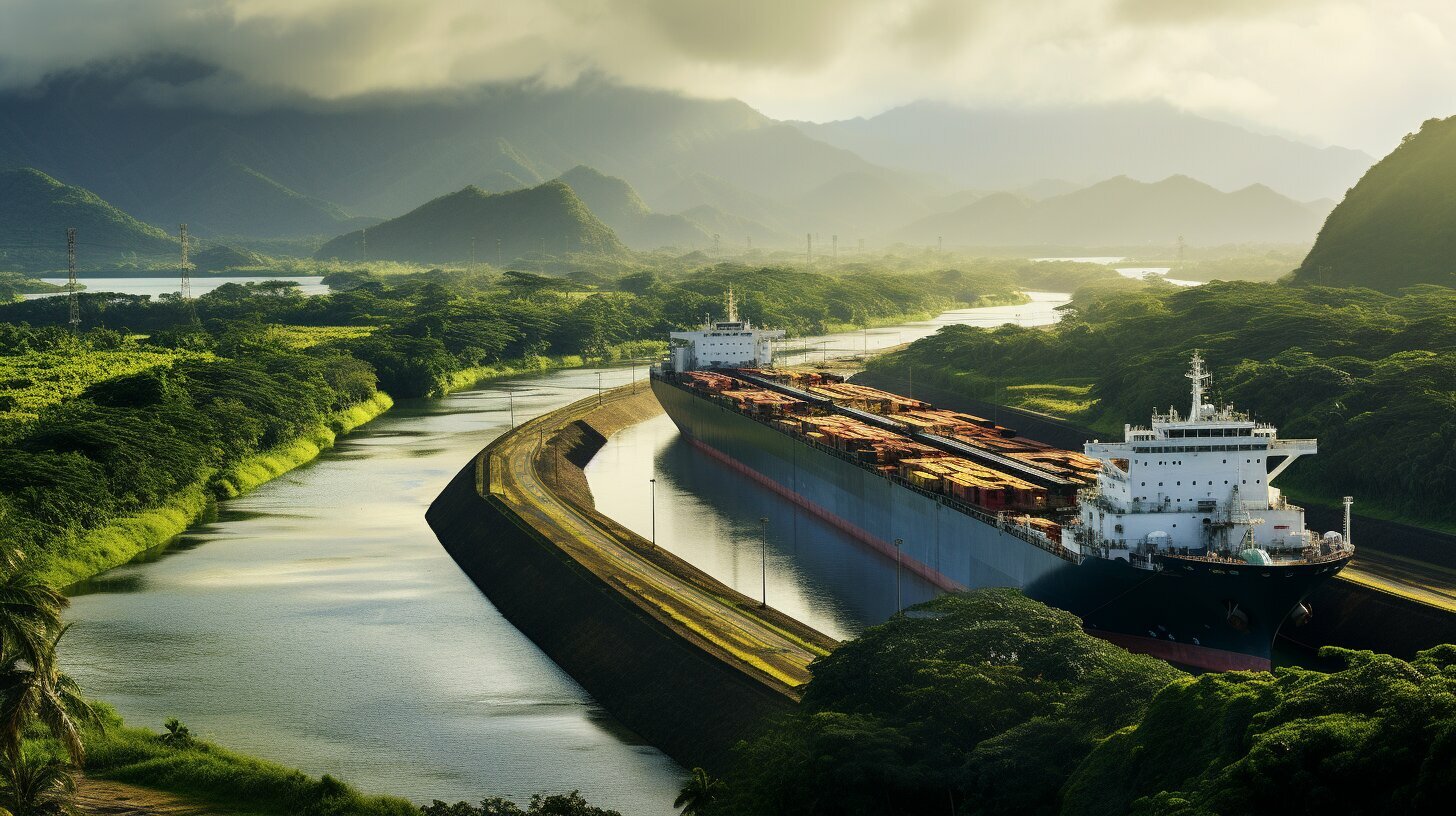What country is the Panama Canal in
The Panama Canal, one of the world’s most important waterways, is located in the country of Panama. This strategic artificial waterway connects the Atlantic Ocean with the Pacific Ocean, providing a vital transportation route for ships. The canal, approximately 40 miles long, saves ships around 8,000 nautical miles compared to going around South America. Owned and administered by the Republic of Panama, it is managed by the Panama Canal Authority. Built by the United States and completed in 1914, the Panama Canal consists of locks that lift and lower ships to different water levels.
Key Takeaways:
- The Panama Canal is located in the country of Panama, in Central America.
- It is a strategic artificial waterway that connects the Atlantic and Pacific Oceans.
- The canal saves ships around 8,000 nautical miles compared to going around South America.
- It is owned by the Republic of Panama and managed by the Panama Canal Authority.
- The United States built and completed the canal in 1914.
Location of the Panama Canal
Situated in Central America, the Panama Canal spans approximately 40 miles and connects the Atlantic Ocean with the Pacific Ocean. This strategic waterway is located in the country of Panama, serving as a vital link between two major bodies of water. Ships that pass through the Panama Canal save around 8,000 nautical miles compared to navigating around the southern tip of South America.
The Panama Canal is a remarkable engineering feat, allowing vessels to cross from one ocean to another efficiently. Its location in the narrowest part of the isthmus of Panama provides an ideal path for international trade. The canal facilitates faster and more cost-effective shipping, enabling goods to reach their destinations in a shorter time, benefiting global commerce.
The canal’s location offers significant advantages, attracting shipping companies and trade routes from around the world. With its proximity to major markets in North and South America, the Panama Canal plays a crucial role in connecting the Atlantic and Pacific regions. It serves as a gateway for maritime traffic, fostering economic growth and ensuring the smooth flow of goods between continents.
Overall, the location of the Panama Canal in the country of Panama positions it as a strategic transportation hub, providing a vital link between the Atlantic and Pacific Oceans. Its significance cannot be overstated, as it serves as a critical artery for international trade and commerce, benefiting countries worldwide.
| Key Information | |
|---|---|
| Location: | Country of Panama, Central America |
| Length: | Approximately 40 miles |
| Connects: | Atlantic Ocean and Pacific Ocean |
| Owner: | Republic of Panama |
| Administration: | Panama Canal Authority |
| Construction: | Completed by the United States in 1914 |
Significance of the Panama Canal
The Panama Canal plays a crucial role in international trade, allowing ships to save around 8,000 nautical miles by avoiding the lengthy journey around South America. As a strategic artificial waterway, it provides a shortcut between the Atlantic and Pacific Oceans, connecting more than 140 maritime routes and facilitating the transportation of goods between major world markets.
One of the main advantages of the Panama Canal is its ability to accommodate large vessels, known as Panamax and Neopanamax ships. These larger ships can pass through the locks of the canal, carrying substantial amounts of cargo. This capability has significantly impacted global trade patterns, allowing for more efficient and cost-effective transportation of goods.
The Panama Canal has also contributed to the economic development and prosperity of the countries connected by the waterway. It has created employment opportunities, stimulated tourism, and boosted the growth of related industries, such as logistics, maritime services, and infrastructure development. The canal has become a vital pillar of the Panamanian economy, generating substantial revenue and attracting international investments.
In summary, the Panama Canal’s significance as a strategic artificial waterway cannot be underestimated. Its ability to shorten travel distances and accommodate large ships has transformed international trade and fostered economic growth. By providing a direct route between the Atlantic and Pacific Oceans, it continues to be a vital lifeline for global commerce.
| Advantages of the Panama Canal | Impact on Global Trade |
|---|---|
| Shortens travel distances by around 8,000 nautical miles | Facilitates efficient and cost-effective transportation of goods |
| Connects more than 140 maritime routes | Enhances trade between major world markets |
| Accommodates large vessels, increasing cargo capacity | Stimulates economic development and job creation |
Ownership and Administration of the Panama Canal
The Panama Canal is owned by the Republic of Panama and is administered by the Panama Canal Authority. As a vital waterway in Central America, the canal plays a crucial role in global trade and transportation. The Republic of Panama, since gaining full control of the canal in 1999, has made significant efforts to maintain and enhance its operations.
The Panama Canal Authority, a government agency, is responsible for the day-to-day management of the canal, ensuring safe and efficient passage of ships. With a strong focus on modernization and sustainability, the Panama Canal Authority has implemented various initiatives to improve navigation, increase capacity, and reduce environmental impact.
One of the notable accomplishments under the administration of the Panama Canal Authority is the expansion project completed in 2016. This project involved the construction of a new set of locks, allowing for the transit of larger vessels and significantly increasing the canal’s capacity. The expansion has enabled the canal to remain competitive and accommodate the growing demands of international trade.
| Ownership | Administration |
|---|---|
| Owned by the Republic of Panama | Administered by the Panama Canal Authority |
In conclusion, the ownership and administration of the Panama Canal by the Republic of Panama and the Panama Canal Authority, respectively, ensure its smooth operation and continued relevance as a strategic waterway. Through ongoing maintenance and innovative projects, the canal continues to facilitate global maritime trade and serve as a cornerstone of Panama’s economy.
History of the Panama Canal
The Panama Canal was built by the United States and was completed in 1914 after years of ambitious engineering efforts. The idea of constructing a waterway to connect the Atlantic and Pacific Oceans dates back to the early 16th century, when explorers first recognized the potential of such a route. However, it wasn’t until the late 19th century that serious efforts were made to bring this dream to reality.
Amidst challenges such as disease, difficult terrain, and complex logistics, the United States took on the task of building the Panama Canal. The project required the excavation of thousands of acres of land, the construction of locks to raise and lower ships, and the creation of a massive artificial lake. Thousands of workers from around the world came to Panama to contribute their skills and labor.
Upon its completion, the Panama Canal revolutionized global trade and shipping. Prior to its existence, ships had to navigate the treacherous Cape Horn route around the tip of South America, adding significant time and cost to voyages. The canal shortened the journey by creating a direct route and saving ships approximately 8,000 nautical miles.
| Key Facts | Values |
|---|---|
| Length of the Panama Canal | Approximately 40 miles |
| Ownership | Republic of Panama |
| Management | Panama Canal Authority |
| Location | Country of Panama, Central America |
Today, the Panama Canal remains an essential conduit for global shipping and a testament to human ingenuity. It continues to be owned and administered by the Republic of Panama, with the Panama Canal Authority overseeing its management and operations. The canal’s system of locks, which raise and lower ships to different water levels, enables vessels of all sizes to traverse the waterway smoothly and efficiently.
In conclusion, the Panama Canal stands as a remarkable feat of engineering and a vital link in international trade. Its construction by the United States and completion in 1914 was a turning point in maritime history, connecting the world’s two largest oceans and revolutionizing global commerce.
Operations of the Panama Canal
The Panama Canal operates through a series of locks that enable ships to navigate through the different water levels of the canal. These locks, known as the Miraflores and Pedro Miguel Locks, play a crucial role in the efficient functioning of the canal.
When a ship approaches the Panama Canal, it enters one of the locks, and water is gradually added or removed to adjust the ship’s elevation. This process allows vessels to transit through the canal, overcoming the difference in water levels between the Atlantic and Pacific Oceans.
The lock chambers are 110 feet wide, 1,000 feet long, and 85 feet deep, accommodating large ships of all sizes. Ships are guided by locomotives, called mules, which keep them centered within the lock chambers as they ascend or descend. The mules use steel cables to ensure safe passage through the locks.
Once a ship completes its passage through the locks, it continues its journey along the canal, which includes passing through the Gaillard Cut, a section of the canal through the Continental Divide. This stretch of the canal is surrounded by lush rainforests, offering a beautiful and scenic experience to those onboard.
| Locks | Dimensions | Quantity |
|---|---|---|
| Miraflores Locks | 110 ft wide, 1,000 ft long, 85 ft deep | 2 |
| Pedro Miguel Locks | 110 ft wide, 1,000 ft long, 85 ft deep | 1 |
In addition to the locks, the Panama Canal also has a system of lakes and channels that allow ships to navigate the waterway. The Gatun Lake, one of the largest man-made lakes in the world, provides a stable water level and serves as a reservoir to supply water for the locks’ operation.
The operations of the Panama Canal involve precision and careful coordination to ensure the safe and efficient passage of ships through this strategic artificial waterway. With its remarkable engineering and innovative lock system, the Panama Canal continues to be a vital route for global maritime trade, connecting the Atlantic and Pacific Oceans.
Conclusion
The Panama Canal, located in Panama, remains a pivotal route connecting the Atlantic and Pacific Oceans, playing a crucial role in global trade and transportation. Spanning approximately 40 miles, this strategic artificial waterway has revolutionized maritime travel, saving ships around 8,000 nautical miles compared to navigating around South America.
Owned and administered by the Republic of Panama, the Panama Canal is expertly managed by the Panama Canal Authority. Its construction was a monumental feat, spearheaded by the United States and completed in 1914, forever altering global shipping routes.
One of the Panama Canal’s remarkable features is its system of locks, allowing ships to navigate through various water levels. This engineering marvel ensures the safe and efficient passage of vessels, enabling trade between continents and facilitating economic growth worldwide.
Located in Central America, the Panama Canal serves as a vital link between the Atlantic and Pacific Oceans, making it an indispensable waterway for international commerce. Its strategic position allows for the seamless flow of goods and resources, connecting nations and fostering global cooperation.
FAQ
Q: What country is the Panama Canal in?
A: The Panama Canal is located in the country of Panama in Central America.
Q: Where is the Panama Canal located?
A: The Panama Canal is situated in Panama, a country in Central America.
Q: What is the significance of the Panama Canal?
A: The Panama Canal is a strategic artificial waterway that serves as a major global transportation route, saving ships around 8,000 nautical miles compared to going around South America.
Q: Who owns and administers the Panama Canal?
A: The Panama Canal is owned by the Republic of Panama and managed by the Panama Canal Authority.
Q: When was the Panama Canal completed?
A: The Panama Canal was built by the United States and completed in 1914.
Q: How does the Panama Canal operate?
A: The Panama Canal operates using a system of locks that lift and lower ships to different water levels, allowing them to navigate through the canal.
Q: What is the conclusion about the Panama Canal?
A: The Panama Canal, located in Panama, is a vital waterway in Central America, connecting the Atlantic Ocean with the Pacific Ocean and providing a crucial shortcut for global maritime trade.



